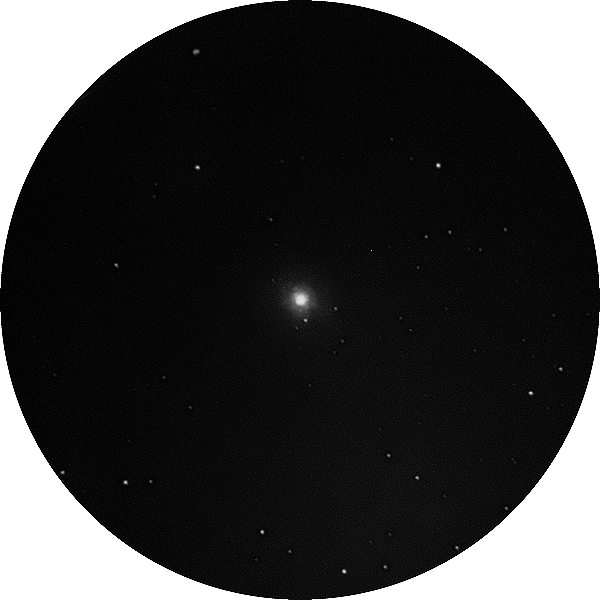Smokey Sky (again),
iPhone Comet NEOWISE, Messier Globular Clusters
Posted: 6 August 2020
Friday, 31 July 2020, was mostly clear and warm. The temperatures the past few days have set high records in much of the state of Arizona. What a time for my observatory Air Conditioner to act up due to an electrical issue.

I propped the dome slightly open to compensate a little for the resulting high temperature in the observatory. Monsoon storm clouds began appearing in the southeastern sky mid-afternoon. About an hour before sunset I went to the observatory to fully close the dome. There was a small double rainbow visible to the southeast.


Saturday, 1 August, was mostly clear until late afternoon when nearby thunderstorms clouded up much of the sky. Missed out on the nice Saturn-Moon-Jupiter conjunction that night due to an overcast sky. Sunday, 2 August, was very hazy with some clouds. The haze was actually smoke from the large, vehicle-caused, Apple Fire in southern California, and is visible as the brown areas in this iPhone 11 Pro Max photo of the western sky over Cassiopeia Observatory. As sunset approached the setting Sun was very red, as seen in the D850 DSLR telephoto lens photograph.


Even the near full Moon was somewhat orange Sunday night when it was high in the night sky (D850 DSLR, f/5.6, 1/250sec, FL 300mm, cropped).

Monday, 3 August, was cloudy with some smoke in the sky. Had a brief rain shower mid-day (0.01"). Tuesday, 4 August, was partly cloudy with still some smoke visible. Wednesday, 5 August was partly cloudy during the day but the sky began clearing late afternoon.
|
Open: Wednesday, 5 August 2020, 1855 MST Temperature: 104°F |
Session: 1505 Conditions: Mostly clear |
Equipment:
12" f/8 LX600 w/StarLock
2" 24mm UWA eyepiece
2" 50mm UWA eyepiece
1.25" 15mm UWA eyepiece
Camera:
iPhone 11 Pro Max
1905 MST: began relaxing on the observatory patio bench.
1921 MST: sunset.
2000 MST: LX600 ON, StarLock OFF, High Precision OFF.
Viewed Jupiter and four moons, 102X. Viewed Saturn and four moons, 102X. Both planets were low in the southeastern sky.
2010 MST: Slewed to Comet C/2020 F3 NEOWISE. The comet's coma was nicely viewed at 102X and 49X, but no tail was visible. Also viewed the comet using 12x50 binoculars. Large coma easily seen.
Mounted the iPhone 11 Pro Max on the 2" 50mm eyepiece using the Levenhuk adapter.
2028 MST: StarLock ON.
Comet C/2020 F3 NEOWISE, afocal 49X, StarLock autoguided, taken with the iOS app NightCap Camera (Long Exposure, Light Boost, ISO 12500, 1sec, 1 minute exposure, 1X lens).

Switched to the 1.25" 15mm eyepiece for iPhone Messier Catalog globular cluster imaging.
2044 MST: High Precision ON.
Imaged the following globular clusters, afocal 163X, StarLock autoguided, NightCap Camera (Long Exposure, Light Boost, ISO 12500, 1sec, 1 minute exposure, 1X lens).
M22

M54

M69

M70

As the eastern sky was brightening from the rising waning gibbous Moon, ended imaging.
2116 MST: StarLock OFF, High Precision OFF
Viewed Jupiter and Saturn, now higher in the sky, 163X. Nice views of both planets.
2122 MST: LX600 OFF.
|
Close: Wednesday, 5 August 2020, 2132 MST Temperature: 83°F |
Session Length: 2h 37m Conditions: Clear |
I have updated my Astronomy Mementos photo album. If you have not checked it out recently, take a look. Most recent additions are at the bottom.
Note to visitors: if you send me a question or comment please ensure that your email address is valid. Too often I receive emails, especially from outlook.com and hotmail.com users with invalid "reply-to" addresses. Typically these are of the form "outlook_abunchofnumbers@outlook.com". If my reply to you bounces, I will not try again.
The Indiana University College of Arts & Sciences has published an article "The Art of Science". I am honored to have been selected as one of the featured "artists". Check it out.
Comments are welcome using Email. Twitter users can use the button below to tweet this report to their followers. Thanks.
Cassiopeia Observatory Home Page
Copyright ©2020 Michael L. Weasner / mweasner@me.com
URL = http://www.weasner.com/co/Reports/2020/08/06/index.html
